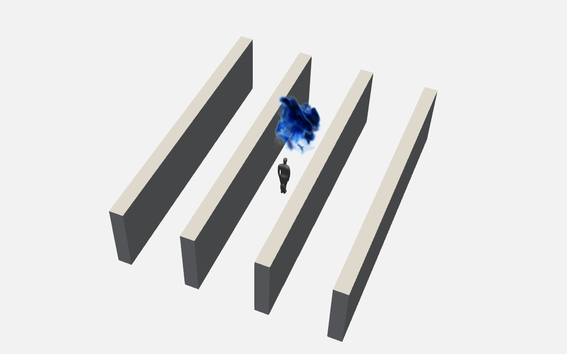Researchers modelling the spread of the coronavirus emphasise the importance of avoiding busy indoor spaces
Aalto University, Finnish Meteorological Institute, VTT Technical Research Centre of Finland and University of Helsinki have studied how extremely small airborne aerosol particles emitted from the respiratory tract when coughing, sneezing or even talking are transported in the air. Such particles can carry pathogens such as coronaviruses.
The researchers modelled a scenario where a person coughs in an aisle between shelves, like those found in grocery stores; and taking into consideration the ventilation. Aalto University, VTT Technical Research Centre of Finland and Finnish Meteorological Institute each carried out the modelling independently, using the same starting conditions.
The researchers obtained the same preliminary result: in the situation under investigation, the aerosol cloud spreads outside the immediate vicinity of the coughing person and dilutes in the process. However, this can take up to several minutes. ‘Someone infected by the coronavirus, can cough and walk away, but then leave behind extremely small aerosol particles carrying the coronavirus. These particles could then end up in the respiratory tract of others in the vicinity’, explains Aalto University Assistant Professor Ville Vuorinen.
‘The preliminary results obtained by the consortium highlight the importance of our recommendations. The Finnish Institute for Health and Welfare recommends that you stay at home if you are unwell and that you maintain physical distance with everyone. The instructions also include coughing into your sleeve or a tissue and taking care of good hand hygiene’, says Jussi Sane, Chief Specialist at the Finnish Institute for Health and Welfare.
‘Based on the modelling of the consortium, it is not yet possible to directly issue new recommendations. However, these results are an important part of the whole, and they should be compared with the data from real-life epidemic studies,’ Sane adds.
The spread of diseases through social networks has been studied extensively. From these infection models, it is known that the spread of a virus may slow down or even be suppressed altogether as mobility decreases at ‘nodal points’ – places where lots of people gather, such as shops, restaurants and public transport. Avoiding busy indoor areas reduces the risk of droplet infection while in close proximity to others, which, according to current information, is the main cause of coronavirus infection.
The researchers of the consortium modelled the airborne movement of aerosol particles smaller than 20 micrometres. For a dry cough, which is a typical symptom of the current coronavirus, the particle size is typically less than 15 micrometres. Extremely small particles of this size do not sink on the floor, but instead, move along in the air currents or remain floating in the same place. Studies of influenza A have confirmed that the influenza A virus can be found in the smallest particles, which measure less than 5 micrometres.

Supercomputer used for modelling
The project involves around 30 researchers, whose specialisations include fluid dynamics, aerosol physics, social networks, ventilation, virology and biomedical engineering. The research is being carried out in conjunction with Essote (the joint municipal authority for social and health services in South Savo), which proposed the research project, as well as infectious diseases specialists from the Finnish Institute for Health and Welfare.
The airborne transport and preservation of droplets leaving the respiratory tract were simulated using a supercomputer, and 3D visualisation of the results was then carried out. CSC – Finnish IT Center for Science Ltd. made its supercomputer available to researchers at very short notice. Thanks to the high computing capacity and close, multidisciplinary cooperation, the first results were produced in around a week.
The physics of the phenomena now being modelled are very familiar from previous research. The consortium aims to use visualisation to create a better understanding of the behaviour of aerosol particles. Researchers will continue to work on the modelling and further refine it. Experts in infectious diseases and virology will examine the results and their importance in relation to the information being gathered on coronavirus and coronavirus infections. The involvement of two Swedish universities has further strengthened the consortium.
CSC is prioritising the provision of computing capacity and expert assistance for research aimed at combating the COVID-19 pandemic. If you are working directly on a pandemic research project, please contact [email protected].
Enquiries:
Assistant Professor Ville Vuorinen
Aalto University
tel. +358 (0)50 361 1471
[email protected]
Senior Researcher Antti Hellsten
Finnish Meteorological Institute
tel. +358 (0)29 539 5566
[email protected]
Senior Researcher Aku Karvinen
VTT Technical Research Centre of Finland
tel. +358 (0)40 510 2142
[email protected]
Assistant Professor Tarja Sironen
University of Helsinki
tel. +358 (0)50 447 1588
[email protected]
Peter Råback
CSC – Finnish IT Сentre for Science Ltd
tel. +358 (0)9 457 2080
peter.rå[email protected]
- Published:
- Updated:
Read more news

Success of BATCircle2.0 bolsters Finnish leadership in Li-ion battery supply chain
The Aalto-led collaboration between researchers and industry resulted in impressive research outputs
The butterly effect – bending and turning artificial muscles with light
In the future, the innovation could be used in for example the development of smart textiles, soft robotics and medicine.
‘Off to a flying start’ – a new research team explores bacteria that thrive in extreme conditions
Jarno Mäkelä joined Aalto’s Department of Neuroscience and Medical Engineering as Assistant Professor of Biophysics in early September, together with research fellow Taras Redchuk, postdoctoral researchers Dan Noel, Eveliny Nery, doctoral researchers Ada Pajari and Aakeel Wagay, and research assistant Chris Hayes. They were accompanied by equipment, funding from the Academy of Finland and an ERC Starting Grant from the European Research Council.